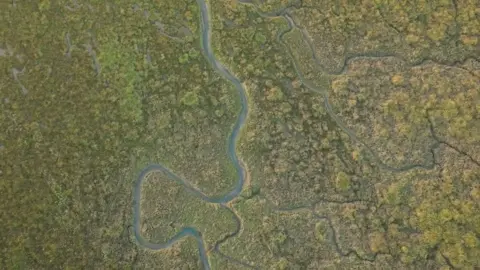**The Importance of UK Saltmarshes in Climate Change Mitigation**
A recent report by the World Wildlife Fund (WWF) emphasizes the critical role that the United Kingdom’s saltmarshes play as valuable “sinks” for climate-warming greenhouse gases. These marshes, primarily consisting of muddy wetlands, have been largely neglected in discussions about climate mitigation strategies, yet they are indispensable in the fight against climate change.
The report highlights that the UK’s saltmarshes have seen significant decline, primarily due to agricultural developments, which have led to a staggering loss of about 85% since 1860. Historically, these zones were viewed as unproductive land and drained for farming purposes. However, WWF asserts that they are critical ecosystems deserving of recognition and protection, and calls for their inclusion in official carbon inventories that measure carbon emissions and removals.
The WWF aims to enhance awareness and incentivize restoration efforts by advocating formal acknowledgment of these habitats within the climate change mitigation framework of the UK. By including saltmarshes in carbon accounting, it would underscore their role in absorbing carbon dioxide, thus promoting a crucial incentive for their restoration and conservation.
WWF’s study underscores significant fieldwork conducted with researchers from the UK’s Centre for Ecology and Hydrology, particularly focusing on Hesketh Out Marsh in North-West England. This site has undergone restoration efforts and is now managed by the Royal Society for the Protection of Birds (RSPB). Using solar-powered greenhouse gas monitoring stations, the team has been able to collect and analyze data on carbon dynamics within the marsh.
One notable finding indicates that plants in the saltmarsh “breathe in” more carbon dioxide during the summer months than they release in the winter. This seasonal analysis exemplifies how saltmarshes function similarly to forests in terms of carbon storage, despite being often overshadowed by trees in environmental discussions.
To facilitate their research, WWF and their partners erected a 2.5-meter high monitoring tower, constructed from scaffolding poles, which allowed them to safeguard the sensitive equipment from tidal flooding and debris. This innovative approach was essential for data collection in such a dynamic environment.
The Hesketh Out Marsh, now thriving with bird species such as avocets and black-tailed godwits, has been revitalized through the RSPB’s efforts. The earlier findings confirm that the marsh’s mud is not only crucial for carbon sequestration but also provides sustenance for various species, serving as a natural buffer between terrestrial and marine ecosystems.
The report titled “The Importance of UK Saltmarshes” was co-published with an insurance company interested in understanding these habitats’ value in mitigating coastal flooding. As climate-related disasters become more frequent, recognizing and investing in such ecosystems may also provide tangible benefits to human populations living nearby, offering natural flood defenses while facilitating biodiversity.
Despite the considerable ecological services provided by saltmarshes, challenges remain. The ongoing loss of these essential habitats poses significant risks not only to wildlife but also to the broader climate and coastal resilience efforts. The WWF emphasizes that urgent measures are needed to restore and protect these unique ecosystems, ensuring they can continue to serve their dual role in carbon sequestration and natural flood defense.
In conclusion, as the effects of climate change become increasingly pervasive, the UK saltmarshes’ role in mitigating greenhouse gases is more critical than ever. By integrating these vital ecosystems into national carbon accounting and conservation frameworks, there lies an opportunity to not only safeguard the environment but also enhance community resilience against the challenges of a changing climate.



